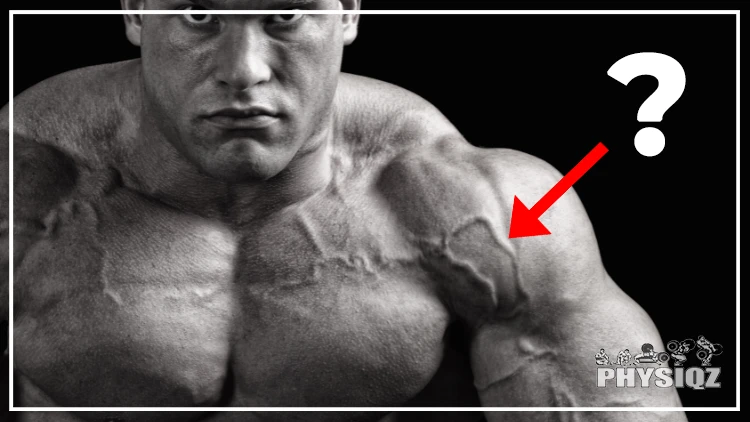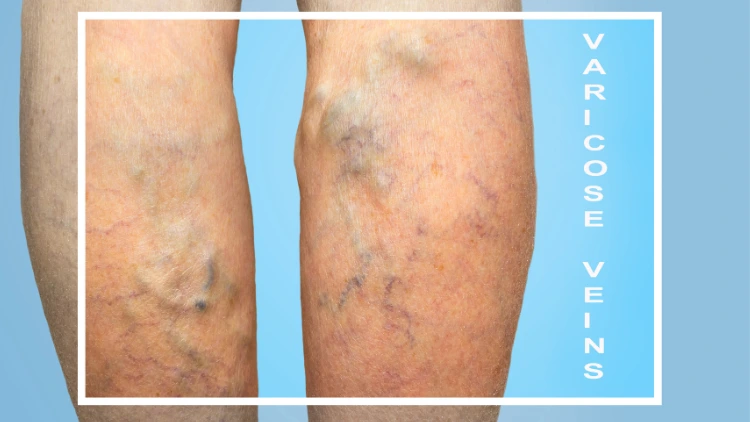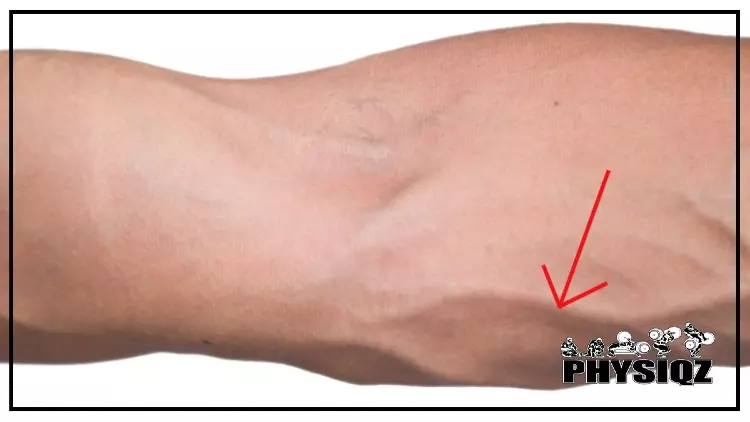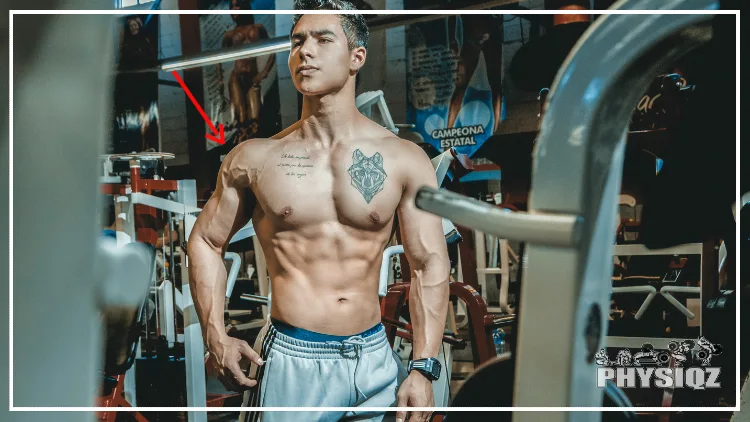
Many discussions on the web suggest that bodybuilding commonly leads to varicose veins; however, it’s unclear whether this is supported by concrete evidence or if it’s merely anecdotal based on forum posts.1
In addition, some may mistake vascularity for varicose veins since they’re both veins that look raised. However, vascularity has an aesthetic appeal and is strived towards while varicose veins aren’t generally not aesthetically pleasing and seen in older populations.
To get to the bottom of varicose veins in relation to weight lifting or bodybuilding, let’s first distinct the differences between vascularity and varicose veins to understand why they happen and how to fix it unsightly varicose veins.
Varicose Veins vs. Vascularity: Are Varicose Veins & Vascularity the Same?
When people think of varicose veins, they usually think of purple or green veins commonly seen on the legs of older people and bodybuilders. They typically look like protruding snakes that wiggle back and forth. This is usually not the desired look and may or may not be a reason for concern.
Vascularity on the other hand is highly sought after in the fitness realm, especially in males who strive for that muscular or “jacked” look. In general, vascularity looks as if someone just has large, natural, free-flowing veins in their normal area. Different from varicose veins, vascularity simply refers to what people assume a vein conventionally looks like: relatively straight, and not brightly colored.
So from the outside, they seem like completely different types of veins that carry blood toward the heart. However, veins are typically paired with an artery that carries blood away from the heart but this isn’t true for either varicose veins or vascularity because they’re what’s referred to as superficial veins.2
The reason they’re called this is that they are usually seen on the surface of the skin and help cool the blood in the body down — although, an obsession over vascularity may also be considered superficial in another manner.3
So yes, both varicose veins and vascularity are the same superficial type of vein, but they still vary in their health implications, look, and come about. Let’s look at each a little further before deep diving into the depths of varicose veins.
Varicose Veins
Again, varicose veins are not a special third type of vein — they are just larger, rope-like superficial veins.4 Also known as varicose, varicose veins seemingly appear at random and the vast majority of people who have varicose develop them in their legs although they typically do not ever develop severe symptoms.
All veins have one-way valves inside of them that only let blood flow toward the heart. When these valves become weakened or damaged, blood can pool in the vein and cause swelling, and eventually, varicose veins.5 There is ongoing debate regarding the consistent causes of varicose veins in humans, including whether they can develop from bodybuilding.

Source: Marina113 via Canva.com6
Vascularity
Again, vascularity is a type of superficial vein that tends to appear with a lower body fat percentage, higher blood pressure, larger muscles, and high levels of hydration, often seen in those who work out.
A significant pump in the gym with higher reps can lead to a higher rate of blood flow and at the same time, the venous outflow is still slower than the arterial inflow, leading to a back-up of blood and higher blood pressure in your veins.7
One other reason why ‘the pump’ causes vascularity is because of swelling in the muscle. As a person works out a specific muscle, that muscle begins to swell, pushing veins closer to the surface of the skin and making them much more pronounced.
In some cases, like varicose veins, working out may not necessarily be the cause of accentuated veins.7

Source: cherryjuicestockphoto via Canva.com8
Normal Causes of Varicose Veins: Why Most People Get Varicose Veins
Varicose veins are typically found, as aforementioned in the legs. They are most common in people who have a family history of the condition, as well as older adults and females. Females, interestingly enough, are four times more likely than men to have varicoses.9 Other associated factors include obesity, pregnancy, and jobs that necessitate standing for a long period.
Recent studies are beginning to show that neovascularization, the formation of new blood vessels, may lead to a clinical recurrence of varicose veins.10, 11 Various other sources suggest that venous reflux, or the malfunctioning of veins, is a key factor that leads to varicosity of the veins, and even chronic alcohol consumption may be a link.4
Are Varicose Veins Even Dangerous?
Regardless of how varicose veins are formed, an important thing to note is that varicose veins are not inherently dangerous.7 For the majority of people, they are simply an eyesore — and while they may not be pretty, it is atypical for there to be significant repercussions when leaving varicose veins untreated.
Typically, the worst symptoms are heavy or achy legs, swollen ankles, and in the very worst possible cases, skin ulcers. In all likelihood, though, varicose veins will not get to this level of severity. It is all dependent on actions taken in the future.
Getting Varicose Veins Bodybuilding: Why Do Bodybuilders Get Varicose or Spider Veins?
Bodybuilders tend to do a lot of weightlifting and large amounts of weightlifting, especially without ample rest, can stress the circulatory system due to heightened levels of blood flow to the muscles.12 While there is technically the potential for varicose veins in bodybuilding, there is not any research to back up that bodybuilders are more prone to varicose veins.
As aforementioned, varicose veins stem from improperly functioning vein valves that allow for the pooling of blood inside of a vein. Bodybuilding requires ample blood flow to ensure that workouts are effective, and training in itself does overall general blood flow. Many people also engage in some form of cardiovascular training, which further enhances blood flow.13
That being said, if a person engages in moderate amounts of weightlifting like back squats and/or cardio, their veins should not develop any issues, other than becoming more prominent due to lowered subcutaneous body fat.
Is it Normal to Get Varicose Veins or Bulging Veins When Bodybuilding?
As already mentioned, vascularity, or the enhanced appearance of superficial veins, does stem from bodybuilding, as veins naturally appear thicker or larger as a person’s body fat levels drop.
Based on the current research available, there does not seem to be a strong association between the occurrence or recurrence of varicose veins and bodybuilding, although personal anecdotes on the web have different views.14
Estrogen & Anabolic Steroids
There are some studies that suggest the occurrence of varicose veins is related to heightened estrogen levels.15 This is a plausible explanation for why women get varicose veins much more frequently than men.
Further, the aforementioned anecdotes on the web specifically pertain to the use of anabolic steroids. Due to the long-term effects of steroids, primarily increased estrogen levels and increased blood viscosity, it is likely that there is a connection between anabolic steroid usage and the occurrence of varicose veins.16
However, until more research is done, it is difficult to conclusively say if there is a strong correlation between anabolic steroid usage and varicose veins. In general, bodybuilders with a genetic predisposition to varicose veins who give their bodies little time to recover can potentially develop weak vein valves over time.
Does Weightlifting Alone Cause Varicose Veins?
On its own, weightlifting seems like it only benefits blood flow. Any exercise, like deadlifts, increases circulation, and the lifting of heavy weights (relative to a person’s musculature) only puts more pressure on the venous system. Dosed in proper amounts, this stress ensures that a person’s veins are constantly getting ‘trained’.
Over a long period and without proper rest, individuals who are genetically predisposed to having varicose veins could develop weakened venous valves due to weightlifting. These valves could worsen to the point where varicose veins begin to appear. In this case, varicose veins bodybuilding is a large possibility.
However, the probability of this occurring is likely similar in extremely inactive individuals, as people with sedentary jobs tend to have poor blood circulation. This means that weightlifting should not make a difference in a person’s likelihood of developing varicose veins.17
Do All Athletes Get Varicose Veins?
Due to the high amount of stress athletes put their legs under, it is entirely possible for athletes to get varicose veins. Coupled with a genetic predisposition to varicoses, this may be even more likely to occur than for the common person.
However, those who train frequently, like in a 6-day workout routine plan, and have a solid amount of recovery are unlikely to get varicose veins. This training frequency is enough to provide a large amount of circulatory training for the veins and assuming there is enough recovery, there should not be any complications.
But Are Athletes More Likely to Get Varicose Veins?

Source: Sabel Blanco via Canva.com18
Based on the current research, athletes are not more likely to get varicose veins than non-athletes.19 Athletes, as a general rule, get more blood flow than the average individual and improve their circulation through constant activity.
Even athletes who do deadlift workouts, which require the usage of many leg muscles, are not more likely to get varicoses. And the likelihood of it happening does not typically change among individuals, except for those who are predisposed to getting them.20
How to Avoid & Fix Getting Varicose Veins
Here are some practical steps individuals can take to prevent and manage varicose or spider veins.
Avoid Inactivity
As mentioned previously, avoiding prolonged periods of sitting or standing is the primary way to prevent varicose veins. Being in either of these positions for too long allows blood to travel and pool in the leg veins due to gravity.
This leads to increased pressure in leg veins, and possible impairment of valve operation.21 Carrying excess weight can increase the risk of developing varicose veins; adopting strategies to quickly reduce weight may help prevent this condition.
Wear Compression Clothing
There are different types of compression clothing on the market: compression shorts, belts, braces, and wraps. People primarily use compressions socks or stockings to prevent varicose veins — due to how tight these types of socks fit, the veins underneath tend to get held steady, preventing vein valves from being misaligned and malfunctioning.
Wearing compression socks while working out may be beneficial for some individuals, as well. Engaging in bodybuilding can help reduce the risk of developing varicose veins because it minimizes the likelihood of vein valve misalignment. However, treating existing varicose veins requires a different approach.
Venous Perforator Vein Surgery
New studies suggest that venous perforator vein surgery is effective at stopping venous reflux, or malfunctioning, in incompetent perforator veins (IPVs).22 Essentially, perforator veins link deep veins to superficial veins, allowing for the passage of blood between them.23 This surgery ensures that blood flow continues to be consistent between deep and superficial veins, allowing for proper functioning.
Sclerotherapy
One of the easiest techniques to get rid of varicoses, sclerotherapy involves the injection of a solution or foam into varicose veins. This solution forces your blood vessel lining to expand by aggravating the lining itself, which ends up forcing it to stick together. These veins subsequently scar and close, and over a few weeks, fade away.
In some cases, larger varicose veins may need to be injected multiple times. Luckily, treatment rarely requires recovery or even anesthesia.24
In all cases, it is a good idea to talk with your primary care provider to determine if sclerotherapy would be safe for you. Some people may not be eligible for sclerotherapy due to factors like pregnancy or a history of blood clotting.
Laser Treatment to Fix Varicose Veins Bodybuilding
Laser treatment is the second most common treatment, and it requires zero incisions.
Laser treatment uses a laser to send a thin beam of radiation in the form of light energy. After shining the laser on the desired varicose vein, the vein shrinks and develops scar tissue. The combination of shrinkage and development of scar tissue seals off the vein, forcing blood to flow through other veins instead.24
Catheter Procedures
Another common treatment is a catheter-based procedure. These treatments tend to vary by provider, specifically in the type of light used. Regardless, the process is the same.
The health care provider inserts a catheter into a varicose vein and heats the catheter tip with a laser or radiofrequency. The high heat causes the vein to collapse, shrink, and seal shut; after the catheter is removed, treatment is finished (20).
Ambulatory Phlebectomy
An ambulatory phlebectomy, similar to sclerotherapy, involves puncturing the skin. Here, however, small varicose veins are pricked through a series of minuscule skin pictures. Anesthesia is typically used in the parts of the body where the phlebectomy is being done.
After the procedure is finished, scarring and recovery are minimal.24
Vein Stripping
Lastly, vein stripping, also known as ‘high litigation’, is the removal of entire veins. You heard that right — but it is done in a very simple, safe manner.
First, the suspect vein is tied off immediately before it joins a deep vein to remove any blood flowing through it and is subsequently removed via small incisions. Similar to a phlebectomy, the vein is tied off before removal forces the venous system to use nearby veins to transport blood instead.24
Although there are ways to avoid varicose veins bodybuilding, there’s also ways to treat them even though there’s no correlation between weight lifting and varicose veins since it’s mainly due to genetic predisposition.
Frequently Asked Questions
What Happens If or When Varicose Veins Burst?
If a varicose vein bursts internally, bruising is likely the worst thing that will occur. If the rupture is large enough, dizziness and possibly even fainting can occur. Taking it easy is the best treatment if this occurs.
However, if the skin above the rupture breaks, significant bleeding will likely occur. This can be dangerous – it is highly advised to put immediate pressure on the area and seek medical assistance.
When Are Varicose Veins Dangerous?
Varicose veins could develop into something worse if the skin or veins are discolored, swollen, painful to the touch, or bleeding.
While it is rare for varicose veins to be dangerous, if a person is concerned with how they look or if they’re uncomfortable, it’s a good idea to get in touch with a healthcare professional.
References
1vuk8691. “Bodybuilder.” Canva. Accessed 11 April 2023. <https://www.canva.com/photos/MADOLtwy1Pc-bodybuilder/>
2Nicola, S. (2021, November 22). Artery vs Vein vs Capillary: What are the Different Types of Blood Vessels? WebMD. Retrieved August 16, 2022, from <https://www.webmd.com/heart/difference-between-arteries-veins-capillaries>
3Superficial vein. (2022, August 4). Wikipedia. Retrieved August 15, 2022, from <https://en.wikipedia.org/wiki/Superficial_vein>
4Varicose veins. (2022, August 10). Wikipedia. Retrieved August 15, 2022, from <https://en.wikipedia.org/wiki/Varicose_veins>
5Miller, C. (2022). 14.4 Blood Vessels – Human Biology. OpenEd@JWU. Retrieved August 15, 2022, from <https://jwu.pressbooks.pub/humanbiology/>
6Marina113. “Varicose veins on a female legs.” Canva. Accessed 8 April 2023. <https://www.canva.com/photos/MADVZyPCpMg-varicose-veins-on-a-female-legs/>
7Shiffer, E. (2018, January 8). Vascularity As a Sign of Fitness Level | Men’s Health. Men’s Health. Retrieved August 15, 2022, from <https://www.menshealth.com/fitness/a19546283/vascularity-and-fitness-level/>
8cherryjuicestockphoto. “Vein in the arm.” Canva. Accessed 11 April 2023. <https://www.canva.com/photos/MADBhSDJ4Pc-vein-in-the-arm/>
9Cleveland Clinic. (2019, December 30). What are Varicose Veins? YouTube. Retrieved August 15, 2022, from <https://www.youtube.com/watch?v=9Wf8bLXVwFI>
10Neovascularization. (2022, March 15). Wikipedia. Retrieved August 15, 2022, from <https://en.wikipedia.org/wiki/Neovascularization>
11Ostler, A. E., Holdstock, J. M., Harrison, C. C., Fernandez-Hart, T. J., & Whiteley, M. S. (2014, June 25). Primary avalvular varicose anomalies are a naturally occurring phenomenon that might be misdiagnosed as neovascular tissue in recurrent varicose veins. Journal of Vascular Surgery: Venous and Lymphatic Disorders, 2(4), 390-396 <https://www.jvsvenous.org/article/S2213-333X(14)00091-2/fulltext>
12Vascularity vs Varicose Veins in Bodybuilding. (2022). Palm Vascular Centers. Retrieved August 15, 2022, from <https://www.palmvascular.com/>
13Weight Training Has Unique Heart Benefits, Study Suggests. (2010, November 11). Medical News Today. Retrieved August 16, 2022, from <https://www.medicalnewstoday.com>
14Kassel, G. (2019, January 14). Does Weightlifting Cause Varicose Veins? Shape. Retrieved August 15, 2022, from <https://www.shape.com/fitness/tips/does-weight-lifting-cause-varicose-veins>
15Raffetto, J. D., Qiao, X., Beauregard, K. G., & Khalil, R. A. (2010, April). Estrogen Receptor-Mediated Enhancement of Venous Relaxation in Female Rat. Implications in Sex-Related Differences in Varicose Veins. NCBI. Retrieved August 17, 2022, from <https://www.ncbi.nlm.nih.gov/pmc/articles/PMC2847594/>
16More Plates More Dates. (2021, November 17). Meathead With Worms For Veins – Healthy Or Not? YouTube. Retrieved August 17, 2022, from <https://www.youtube.com/watch?v=-foJdQHvuvk>
17Sampson, S. (2017, May 17). How to Prevent Varicose Veins: Exercise, Hosiery, and More. Healthline. Retrieved August 16, 2022, from <https://www.healthline.com/health/how-to-prevent-varicose-veins>
18Blanco, Sabel. “Man Inside Gym.” Canva. Accessed 8 April 2023. <https://www.canva.com/photos/MADyQyibsoI-man-inside-gym/>
19Varicose Veins and Athletes – The Surprising Facts. (2022). Lam Vascular & Associates. Retrieved August 15, 2022, from <https://lamvascular.com/all-about-vascular-surgery/>
20Palm Vein Center. (2020, March 23). Bodybuilding: Varicose Veins Or Vascularity? Palm Vein Center. Retrieved August 15, 2022, from <https://www.palmveincenter.com/education/bodybuilding-varicose-veins-or-vascularity>
21Varicose Veins: Causes, Symptoms and Treatment. (2021, December 29). Cleveland Clinic. Retrieved August 15, 2022, from <https://my.clevelandclinic.org/health/diseases/22893-focal-seizure>
22Whiteley, M. S. (2014, September 1). Part One: For the Motion. Venous Perforator Surgery is Proven and Does Reduce Recurrences. European Journal of Vascular & Endovascular Surgery, 48(3), 239-242. <https://www.ejves.com/article/S1078-5884(14)00390-6/fulltext>
23Kuyumcu, G., Salazar, G. M., Prabhakar, A. M., & Ganguli, S. (2016, November 12). Minimally invasive treatments for perforator vein insufficiency. NCBI. Retrieved August 15, 2022, from <https://www.ncbi.nlm.nih.gov/pmc/articles/PMC5220201/>
24Varicose veins – Diagnosis and treatment. (2022, March 3). Mayo Clinic. Retrieved August 16, 2022, from <https://www.mayoclinic.org/diseases-conditions/infectious-diseases/diagnosis-treatment/drc-20351179>